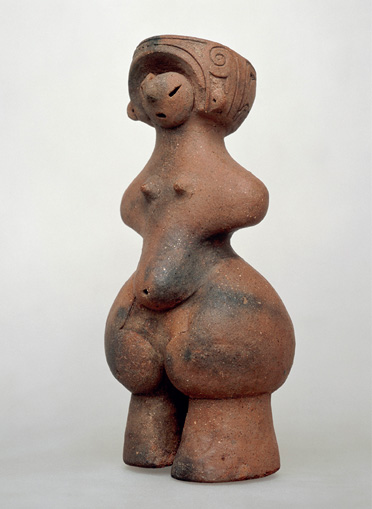| The Power of Dogu: Ceramic figures from ancient Japan |

|

|

|
| Culture | |
| Wednesday, 14 October 2009 | |
|
The exhibition will feature sixty-seven of these extraordinary objects, lent by many different public and private collections in Japan. Three have been designated National Treasures of Japan, including the so-called ‘Venus’ from Tanabatake, Nagano prefecture and Dogū with palms pressed together from Aomori prefecture, designated by the Japanese government in 2009. An additional twenty-five examples rank as Important Cultural Properties and Important Art Objects. This will be the first time that such a wide range of the finest dogū have been brought together in a single exhibition. The exhibition is co-organised with the Agency for Cultural Affairs, Japan, in collaboration with the Tokyo National Museum.
More than 1,000 dogū have been recovered from each of two major sites, Shakadō in Yamanashi prefecture and Sannai Maruyama in prefecture mostly in fragments. Nationwide, the total reported to date is about 18,000. Dogū are made from high quality pottery and come in a variety of shapes featuring intriguing decoration and geometric designs. The techniques include modelling, clay appliqué, marking with twisted plant fibres jōmon means ‘cord-marked’) and burnishing. One of the largest complete figures in the exhibition, from is some 42cm high. However fragments have also been found of much larger examples that must originally have been over one metre in height; such is the head from Shidanai, Iwate prefecture. In addition to their often elaborate decoration, some dogū were painted -- typically with red pigments -- or covered in lacquer. They can take intriguing forms, with heart-shaped faces or triangular pointed heads. Some squat, perhaps in childbirth, others appear to be praying, still others apparently wear masks, such as the magnificent Hollow masked dogū discovered in 2000 in prefecture. Many dogū have recognisably female characteristics, while others appear less gender-specific. They may be hollow or made of solid clay.
In the twentieth century, dogū served as a potent source of artistic inspiration, and in recent decades they have even featured in manga comics and Playstation games. It is testimony to the power of dogū that they can serve, simultaneously, as symbols of prehistoric Japan entrancing works of art; and protagonists in contemporary culture. There will be a free gallery talk on dogū on Wednesday 21 October 2009 at 13:15, Room 91. To accompany this show there will be a contemporary exhibition in Room 3 of the British Museum from 5 November – 3 January 2010 entitled Manga: Professor Munakata’s British Museum adventure. Leading Japanese manga artist Hoshino Yukinobu (b. 1954) will use the British Museum and its collections to create a new manga in which his popular character Prof. Munakata has adventures at the Museum. He has featured many dogu in his popular manga series, so this exhibition shows the link between dogu and contemporary culture. For more information see : www.britishmuseum.org/whats_on/all_current_exhibitions/the_power_of_dogu.aspx. SPECIAL BOOK DISCOUNT OFFER FOR DIMSUM READERS The power of Dogū: Ceramic figures from ancient Japan, edited by Simon Kaner and with contributions from leading experts in the field, is the beautifully illustrated catalogue to accompany the exhibition. Dim Sum readers get 20% off (RPP £19.99, excluding p&p) the book when they book online. To claim the discount click on the link here and use promotional code ‘RO66' at the checkout. Offer valid until end October 2009. IMAGES Top:Goggle-eyed dogū. Kamegaoka, Aomori prefecture. 1000-300BC. Tokyo National Museum. Middle: Tanabatake ‘Venus’. Tanabatake, Nagano prefecture. 2500-1500BC. Chino City Board of Education. Bottom: Clay figure of a wild boar. Tokoshinai, Aomori prefecture. 1500-1000BC. Hirosaki City Museum. Photo credits: © Ogawa Tadahiro |
|






 Dogū, abstract clay figures with recognizably human or animal features, have a fascinating history in Japan, dating back thousands of years. These enigmatic figures have long captured the imagination of antiquarians, archaeologists and the public alike. They provide a tantalising link to the mysterious yet remarkable Jōmon period (about 12,500-300BC) of Japanese history.
Dogū, abstract clay figures with recognizably human or animal features, have a fascinating history in Japan, dating back thousands of years. These enigmatic figures have long captured the imagination of antiquarians, archaeologists and the public alike. They provide a tantalising link to the mysterious yet remarkable Jōmon period (about 12,500-300BC) of Japanese history. Dogū evolved within the earliest dated continuous tradition of pottery manufacture in the world, stretching back to about 12,500 BC. They were produced by the Jōmon people, prehistoric foragers in the temperate forests that covered the Japanese archipelago. Jōmon people lived in tune with the seasons, and shared their rich natural world with the spirits. Since the period (1615–1868) dogū have been excavated from many sites throughout Japan the best examples coming from central and eastern regions -- from where most of the current exhibits are drawn.
Dogū evolved within the earliest dated continuous tradition of pottery manufacture in the world, stretching back to about 12,500 BC. They were produced by the Jōmon people, prehistoric foragers in the temperate forests that covered the Japanese archipelago. Jōmon people lived in tune with the seasons, and shared their rich natural world with the spirits. Since the period (1615–1868) dogū have been excavated from many sites throughout Japan the best examples coming from central and eastern regions -- from where most of the current exhibits are drawn. There is much debate about what dogū meant to Jōmon people and how they were used, particularly because many seem to have been deliberately broken before scattering or burial. In fact, dogū probably fulfilled a range of uses: as embodiments of spirits, venerated and revered; sometimes buried with the deceased to guide them to the next world; and most often fragmented during or after their use in Jōmon rituals. Such rituals were perhaps intended to secure safe childbirth, or ensure a successful hunt.
There is much debate about what dogū meant to Jōmon people and how they were used, particularly because many seem to have been deliberately broken before scattering or burial. In fact, dogū probably fulfilled a range of uses: as embodiments of spirits, venerated and revered; sometimes buried with the deceased to guide them to the next world; and most often fragmented during or after their use in Jōmon rituals. Such rituals were perhaps intended to secure safe childbirth, or ensure a successful hunt.
